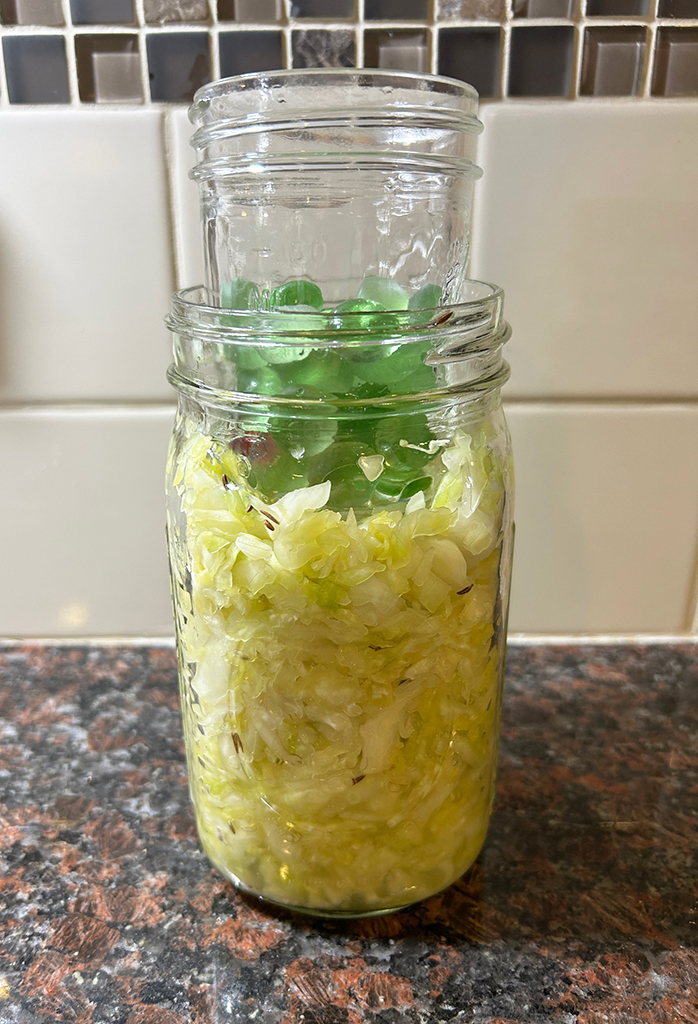by Joyce Peters
Cabbage is one of those overlooked nutrient powerhouses. The cabbage family, which includes arugula, bok choy, broccoli, cauliflower and kale, is rich in folate, vitamins C, E, and K, and fiber. All are good sources of phytonutrients that help lower inflammation and reduce the risk of cancer.
One way to include more cabbage in your meals is to add fermented cabbage. Fermented foods are full of probiotics that help maintain healthy gut microflora. If you have to limit your sodium intake, you should not eat too much but a little goes a long way in improving your meals. Sauerkraut is not only a great addition to sandwiches but elevates a lowly hot dog into a gourmet treat. I especially like it warmed up slightly.
Making your own sauerkraut doesn’t require special equipment and is simple to make. All you need are cabbage, salt and maybe some caraway seeds.
Sauerkraut
Adapted from TheKitchn.com
Ingredients
1 medium head of cabbage (about 3 lbs.)
1 ½ Tablespoons kosher salt
1 Tablespoon caraway seeds (optional, adds a lot of flavor)
Instructions
Clean everything well to eliminate any microorganisms that will interfere with fermentation – a large bowl, 2 quart-sized mason jars, 2 clean empty jelly jars, and a knife. A mandoline or food processor with a slicing disk are handy for quick even slices.
Discard any wilted leaves from the cabbage. Trim out the core. Cut into wedges and slice into thin ribbons. In a large bowl, sprinkle the cabbage with salt. Massage and squeeze the cabbage with your hands. After 5 to 10 minutes of working the cabbage, lots of water will leak out and the cabbage will become limp. Mix in caraway seeds.
Pack the cabbage into the quart jars. Push down with your hands. Any leftover liquid in the bowl should be added to the jars.
Insert the smaller jelly jar into each quart jar. This will keep the cabbage under the fermenting liquid. You can weigh down the jelly jars with water or stones.
Place on a tray to catch any overflow liquid. Cover the filled quart jars with a cloth held down with rubber bands. This allows air circulation and keeps out bugs and dust. Store in a cool place (65-75°) out of direct sunlight. Over the next 24 hours, push down on the jelly jar occasionally to release more water from the cabbage as it becomes more limp.
You want the vegetable to be submerged in the salty liquid. After 24 hours, if you need more liquid, add extra (1 teaspoon salt mixed in 1 cup of water).
Ferment for 3-10 days. Bubbles and foam are signs of fermentation. Check daily and press down to keep cabbage under liquid. Remove any mold that you see – the sauerkraut is still good to eat. Taste to determine that it’s the perfect fermentation level for you. Remove the weight and screw on the cap. Then store in the refrigerator. Your sauerkraut will keep for several months in the refrigerator. Fermentation doesn’t stop; it continues very slowly at cold temperatures.
You can try this technique with red cabbage, Napa cabbage or a mixture.

